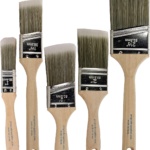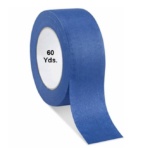1.Choose your color
Browsing through fan decks and paint chips can be overwhelming. Start by figuring out the general color characteristics: Do you want a warm or cool shade? A neutral or a saturated shade? If you have existing furniture or art, you’ll also want to consider how the shade will compliment them. Once you have a sense of what you’re looking for, pick a few shades, and get samples. Test the shades to see how they look in the room at different times of the day.
Many paint companies also have tools on their websites that will let you upload a photo of your space and preview different colors on the walls. But colors can look different in real-world conditions, so you’ll still need to try it out in the space.
2. Pick out your tools
Every project is unique and you may need different tools depending on the paint you choose and the condition of your walls, but there are a few must-haves.
- Paint roller
- Extension pole
- Drop cloths
- Paintbrushes
- Paint try
- Sandpaper
- Paint’s tape
- Rags
- Putty knife
- Plastic Pole Sander Head
3. Determine how much paint you’ll need
Whether you’re painting a powder room or the exterior of your house, the general rule of thumb is one gallon per 350-400 square feet. But that’s just a rough guideline: To get a more precise number, which you’ll definitely want for large projects, use a paint calculator like the ones provided by Benjamin Moore or Pratt & Lambert; they take into account window and door measurements. (And both assume two coats of paint per project.)
If you’re painting a highly textured surface rather than a smooth one, buy a little extra. Cabinets with complicated millwork require more paint, too; C.P.M.-standard requires purchasing about 10 percent more than calculated. Changing any color from dark to light or opposite is not anymore a big deal and only required two coats if you hire professional services like C.P.M. we offer two coats guaranteed. Contact us for more information.
4. Prep the walls and the room
-step 1/prep

You don’t want to damage your favorite sofa or that heirloom Grandma gave you, so empty the room of all the furniture. If you don’t have enough space, push everything to the center. Cover the pieces with a drop cloth or lightweight plastic sheeting and do the same with the floor. “Don’t skip the drop cloth, the paint will splatter, we promise.
– step 2/Prep
-If you need to cover a ceiling light or fan, shut off the circuit breakers to the room and set up a work light. Remove cover plates from switches and outlets. Protect switches with tape. Tape the screws to the back of the plates so you don’t lose them.
-If you’re painting the ceiling, you’ll need to protect hanging fixtures like ceiling fans and pendant lights. For fans, remove the blades, loosen the cover plate and slide it down. Then wrap the fixture with plastic. Hanging pendant lights should have a cover plate that just slides down too.
You should also cover up recessed lights. First, remove the bulb. Then pull the outer trim down just a little bit. Release the springs or wires holding the cover in place and cover with plastic and tape. Now you can the ceiling area covered by the trim.
– step 3/Prep
– To get a nice and smooth finish use Plastic Pole Sander Head and sand all wall surfaces with 100-120 grit sandpaper. After this process you will see all imperfections like nail pops, bumps…
download (5).jfif
– Scrape off the flaking paint with a putty knife. Just remove the loose stuff.
– step 4/Prep
– Grab a roll of painter’s tape—the cousins recommend FrogTape—and firmly apply it to the edges of the room’s corners, base and crown moldings, and door and window casings, using a putty knife to seal if needed. “Getting a good seal so the paint doesn’t get under the tape is everything, plus it will pull away clean after everything is dry,” they say. If you dare (or have an artist’s steady hand), you can skip taping entirely. Remove outlet and light switch covers and apply painters tape to protect outlets and switches from paint drips.











